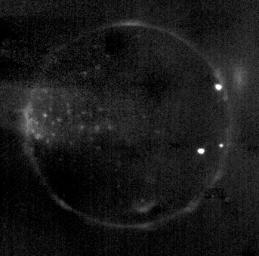- Original Caption Released with Image:
-
This unusual image shows Io glowing in the darkness of Jupiter's shadow. It is a combination of eight images taken by the New Horizons Long Range Reconnaissance Imager (LORRI) between 14:25 and 14:55 Universal Time on February 27, 2007, about 15 hours before the spacecraft's closest approach to Jupiter. North is at the top of the image. Io's surface is invisible in the darkness, but the image reveals glowing hot lava, auroral displays in Io's tenuous atmosphere and volcanic plumes across the moon. The three bright points of light on the right side of Io are incandescent lava at active volcanoes - Pele and Reiden (south of the equator), and a previously unknown volcano near 22 degrees north, 233 degrees west near the edge of the disk at the 2 o'clock position.An auroral glow, produced as intense radiation from Jupiter's magnetosphere bombards Io's atmosphere, outlines the edge of the moon's disk. The glow is patchy because the atmosphere itself is patchy, being denser over active volcanoes. In addition to the near-surface glow, there is a remarkable auroral glow suspended 330 kilometers (200 miles) above the edge of the disk at the 2 o'clock position; perhaps this glowing gas was ejected from the new volcano below it. Another glowing gas plume, above a fainter point of light, is visible just inside Io's disk near the 6 o'clock position; this plume is above another new volcanic eruption discovered by New Horizons.On the left side of the disk, near Io's equator, a cluster of faint dots of light is centered near the point on Io that always faces Jupiter. This is the region where electrical currents connect Io to Jupiter's magnetosphere. It is likely that electrical connections to individual volcanoes are causing the glows seen here, though the details are mysterious.Total exposure time for this image was 16 seconds. The range to Io was 2.8 million kilometers (1.7 million miles), and the image is centered at Io coordinates 7 degrees south, 306 degrees west. The image has been heavily processed to remove scattered light from Jupiter, but some artifacts remain, such as dark patches in the background.
- Image Credit:
-
NASA/Johns Hopkins University Applied Physics Laboratory/Southwest
Research Institute
Image Addition Date: -
2007-05-01
|

 Planetary Data System
Planetary Data System












